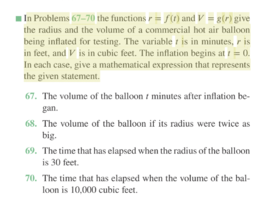You are using an out of date browser. It may not display this or other websites correctly.
You should upgrade or use an alternative browser.
You should upgrade or use an alternative browser.
Composite Functions
- Thread starter Karim
- Start date
Dr.Peterson
Elite Member
- Joined
- Nov 12, 2017
- Messages
- 16,088
I think you're misinterpreting the question, and trying to do more than they want. Did you notice that they don't even tell you that the balloon is spherical? As I read it, they want you to take nothing as given except the (unspecified) functions f and g.Hi! I'm a bit confused about question 69.
I know that in question 67, the answer is v = 4/3 * pi * f(t)^3
and that 68 is 8v given that the radius is increased x2
However, in question 69 they never gave the function of f(t) so I'm confused about how I should go about it
View attachment 34209
For #67, they have told you how the volume depends on the radius, and how the radius depends on time; and you have told us that you are learning about composite functions. (Thanks for doing so -- too many students don't state their context!) Note particularly that they don't tell you the formula for the volume; they just name that function. Don't use the formula for a sphere!
Rather, what composite function gives the volume as a function of time? Just use the named functions f and g, not any assumptions about the balloon.
For #68, again, you don't know what function g is, because you don't know it's a sphere, or even that the shape remains similar so that the volume is proportional to the cube of the radius. All you know is the name of g. How can you use that to answer the question?
Once you see what they are getting at, and that you need to do a lot less than you are trying to do, the rest should be easier.
Dr.Peterson
Elite Member
- Joined
- Nov 12, 2017
- Messages
- 16,088
Yes, #67 is just the composite function g(f(t)); and #68 might be intended to be either your g(2f(t)), or just g(2r). I'm not sure.If I don't know the functions f and g, how will I be able to solve question 69?
The only information I can use in that case is f(t) = 30
Also then I'm guessing the answer for question 68 is simply V = g(2(f(t))
and for 67 it's V = g(f(t))
For #69, you want the value of t for which f(t) = 30. Have you learned about inverse functions yet?
Then #70 will be similar.
As you've guessed, my impression is that this exercise is all about using function notation. I'd be a little more sure if I were tutoring you side by side, and could look at your textbook or notes to see what has been taught most recently, what examples were given, and what other exercises precede and follow this, all of which would provide further context.
Yes, we've done inverse functions.Yes, #67 is just the composite function g(f(t)); and #68 might be intended to be either your g(2f(t)), or just g(2r). I'm not sure.
For #69, you want the value of t for which f(t) = 30. Have you learned about inverse functions yet?
Then #70 will be similar.
As you've guessed, my impression is that this exercise is all about using function notation. I'd be a little more sure if I were tutoring you side by side, and could look at your textbook or notes to see what has been taught most recently, what examples were given, and what other exercises precede and follow this, all of which would provide further context.
So f^-1(30) = t, for 69?
Oooohhh and so
g(f(t)) = 100,000
g^-1(100,000) = f(t)*
f^-1(r)* = t
Is that it? The notation's a bit messy so could you recommend a better way of writing it?
Dr.Peterson
Elite Member
- Joined
- Nov 12, 2017
- Messages
- 16,088
What do the asterisks represent? I suppose you probably mean that that value of r is what you want to use in the next line.Yes, we've done inverse functions.
So f^-1(30) = t, for 69?
Oooohhh and so
g(f(t)) = 100,000
g^-1(100,000) = f(t)*
f^-1(r)* = t
Is that it? The notation's a bit messy so could you recommend a better way of writing it?
To put it all together, you just need another composition: If f(t) = g^-1(100,000), then t = f^-1(g^-1(100,000)).
But I should add one thing: you have to assume, for these last two answers, that f and g are one-to-one functions, so that they have inverse functions. You aren't explicitly told so; but you can probably assume that they are both strictly increasing, never going down as t and r increase, since the balloon is being inflated (not breathed in and out), and a larger radius implies a larger volume (unless the shape changes in a really odd way).

